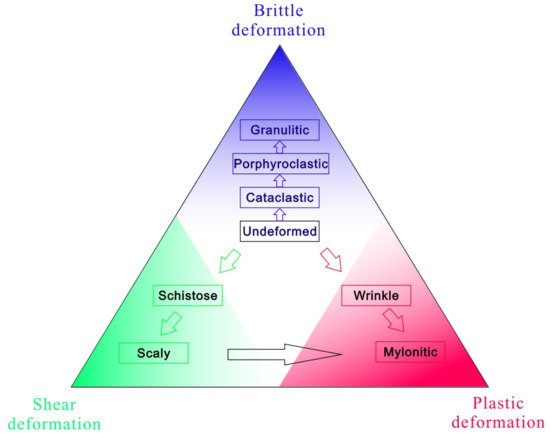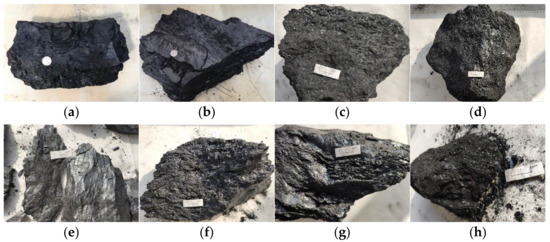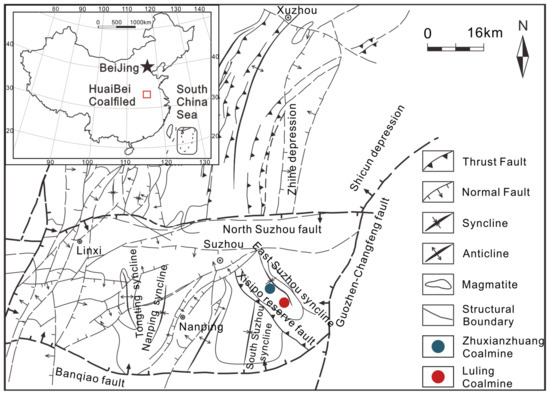You're using an outdated browser. Please upgrade to a modern browser for the best experience.
Please note this is a comparison between Version 1 by Song Xiong and Version 2 by Camila Xu.
Tectonically deformed coal (TDC) is a type of coal in which the primary structure of the coal body has undergone different degrees of embrittlement, fracture or ductile deformation, superimposed damage under the action of one or more periods of tectonic stresses, and even internal chemical composition and structure changes.
- tectonically deformed coal
- ultrasonic testing
- petrophysical parameters
1. Introduction
Tectonically deformed coal (TDC) is a type of coal in which the primary structure of the coal body has undergone different degrees of embrittlement, fracture or ductile deformation, superimposed damage under the action of one or more periods of tectonic stresses, and even internal chemical composition and structure changes [1][2][3][4][5][6][1,2,3,4,5,6]. The main coalfields in China experienced several geological periods and caused complex geological structures, and TDCs are widely developed in coal beds [1][6][7][8][1,6,7,8]. It has been proven that TDCs are closely related to gas outbursts because of their low strength and weak resistance to stresses and deformations [6][9][10][11][12][6,9,10,11,12]. Low-rank TDCs have rich fractures and high permeability compared with undeformed coal [6][13][6,13]. These characteristics are preferred for exploiting coalbed methane (CBM) on the surface and in the underground tunnel [14][15][16][17][18][14,15,16,17,18]. However, the fracture development and permeability of high-rank TDCs are more complicated, and it is more likely unsuitable for direct CBM exploitation [19][20][21][22][23][19,20,21,22,23]. Therefore, it is significant for CBM exploitation and coal mine safety to study the petrophysical properties of TDCs and undeformed coal.
The petrophysical parameters (such as bulk modulus, shear modulus, P-wave velocity, and S-wave velocity) are related to the elastic parameters of rocks and play an essential role in geophysical exploration, including wireline logging and seismic surveys [24][25][24,25]. Like seismic inversion in oil and gas reservoirs, seismic inversion in coal fields needs the quantitative association of density, velocity, and their mutual conversion to reduce the embedded uncertainty and ambiguity [26][27][26,27]. With the large-scale exploration and production of coals and CBMs in China, the study of the petrophysical properties of coals has attracted extensive attention and resulted in many applications [6][28][29][30][6,28,29,30]. Although researchers have measured undeformed coals and TDCs, the petrophysical parameters and related distributing characteristics in the Huaibei coalfield are poorly studied.
Dynamic measurements of petrophysical parameters in the lab can simulate actual formation conditions and provide helpful information for geophysical exploration [31][32][33][31,32,33]. As for coal, researchers have studied the petrophysical parameters in the lab using ultrasonic testing for some metamorphic and deformed coals under room temperature and pressure conditions [7][34][35][36][37][7,34,35,36,37]. Researchers have also measured the velocity anisotropy of P and S waves in the lab for some types of coals with transmission and reflection methods [38]. Besides testing in the lab, some researchers have measured the petrophysical parameters of coal in underground roadways of coal mines to avoid the difficulty of coal sampling and preparation [39]. Although researchers have attempted to address the petrophysical parameters of coalbeds, some high-level deformed TDCs are not obtained because their fragile characteristics made the core sampling and preparation hard.
2. Geological Background
2.1. Geological Setting
The Huaibei coalfield is located on the southeast margin of the North China Plate. The main body belongs to the Xu-Su sag in the south-central part of the Luxi-Xuhuai Uplift [9]. The active belts on the south and east sides of the plate margin control the structural framework. The formation of the Mesozoic Xu-Su arc double-impact imbricated fan reverse fault system established the main structural framework of this area [9], characterized by linearly compact closed folds and thrust imbricated fan faults (Figure 1). The Zhuxianzhuang and Luling coal mines are located in the southern part of the Huaibei Coalfield and are bounded to the south by the Xisipo faults (Figure 1). The coal seams in the Huaibei Coalfield have been strongly deformed due to previous multistage tectonic events [9][40][41][9,43,44]. Thus, a full suite of TDCs is widely developed in the Zhuxianzhuang and Luling coal mines, making these two mines ideal places for TDC research [42][43][45,46]. The strata presented in the Huaibei Coalfield are the upper Proterozoic, Sinian, Cambrian, Ordovician, Carboniferous, Permian, Triassic, Jurassic, Cretaceous, Paleogene, Neogene, and Quaternary strata [1][44][1,47]. The coal-bearing strata in the coalfield belong to the lower Permian Shanxi Formation and the middle Permian Lower Shihezi Formation [38][45][38,48]. The main mineable coal seams in this area are the No. 8 coal of the Lower Shihezi Formation and the No.10 coal of the Shanxi Formation.2.2. Core Sampling and Preparation
TDC samples were collected from typical TDC-rich coalbeds in the Zhuxianzhuang and Luling coal mines according to the China National Standards [46][49]. The sampling sites were on the fresh working faces and tunneling roadways in the coal mines. To prevent coal samples from being damaged during the sampling process, geological hammers were used carefully to preserve the original coal structures, and then samples were wrapped up with soft paper followed by adhesive tape with marks on the ends. The samples were placed in plastic storage bags to prevent contamination and minimize oxidation after collection. Then, the samples were immediately transported to the laboratory for observation, preparation, and experimentation. According to the structure–genetic classification system of TDCs [1][6][10][1,6,10], the coal samples were classified into undeformed, cataclastic, porphyroclastic, granulitic, schistose, scaly, wrinkle, and mylonitic coals, as shown in Table 1. Among them, two samples of undeformed coal were used for comparison purposes. For a clearer explanation, the deformation environment and structure evolution of TDCs are summarized, as shown in Figure 2.
Figure 2.
Sketch map of deformation environment and structure evolution of TDCs.
According to the deformation environment, the tectonic deformation process of TDCs includes three classes, i.e., brittleness, shear, and plastic deformation environment. In Figure 2, different colors are used to distinguish different deformation environments, and color shades are used to indicate the strength of the deformation degree. The TDCs resulting from plastic deformations are wrinkle and mylonitic coals characterized by ductile bending, rheology, and mylonitization structures. Photos of the original coal samples collected in this study are shown in Figure 3. Before preparation, these samples were classified into corresponding types based on their stiffness, macrostructure, and other visual characteristics. After classification, original coal samples were cut into small sizes by wire saw and then ground by hand into cubic cores with sandpaper under dry conditions.
 . Before preparation, these samples were classified into corresponding types based on their stiffness, macrostructure, and other visual characteristics. After classification, original coal samples were cut into small sizes by wire saw and then ground by hand into cubic cores with sandpaper under dry conditions.
. Before preparation, these samples were classified into corresponding types based on their stiffness, macrostructure, and other visual characteristics. After classification, original coal samples were cut into small sizes by wire saw and then ground by hand into cubic cores with sandpaper under dry conditions. 
Figure 3. Photos of different types of TDCs: (a) undeformed coal; (b) cataclastic coal; (c) porphyroclastic coal; (d) granulitic coal; (e) schistose coal; (f) scaly coal; (g) wrinkle coal; and (h) mylonitic coal.

